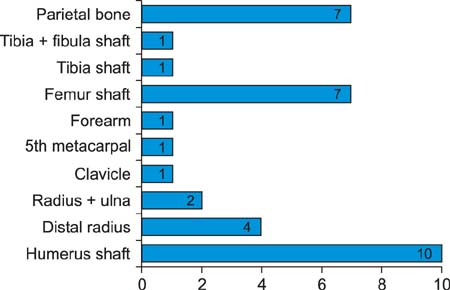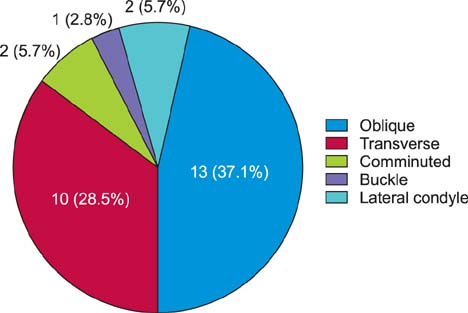Clin Orthop Surg.
2014 Dec;6(4):432-438. 10.4055/cios.2014.6.4.432.
Pattern of Fractures in Non-Accidental Injuries in the Pediatric Population in Singapore
- Affiliations
-
- 1Department of Orthopaedics Surgery, KK Women's and Children's Hospital, Singapore. Sumanth.Kumar@kkh.com.sg
- KMID: 1794732
- DOI: http://doi.org/10.4055/cios.2014.6.4.432
Abstract
- BACKGROUND
Fractures as a result of non-accidental injuries (NAI) are not uncommon among children. The purpose of our study was to describe the incidence, demographic characteristics, and associated risk factors in patients with NAI in a multiethnic Asian cohort.
METHODS
A retrospective record review of patients admitted to our hospital between September 2007 and 2009 with the diagnosis of NAI was conducted.
RESULTS
A total of 978 children were reported with suspicion of NAI. Among them, 570 patients (58.28%) were diagnosed with NAI. Fractures were observed in 35 children (6.14%). NAI fractures were highest among female infants (73.3%). The biological father was the most common known perpetrator of NAI (n = 155, 29.0%). The most common perpetrator sadly remained unknown (n = 14, 40%). All NAI fractures were closed (n = 35, 6.14%), and the most commonly affected bone was the humeral shaft (n = 10, 28.57%) with an oblique configuration. Age < 1 year and parental divorce were significant risk factors associated with these fractures.
CONCLUSIONS
The skeletal injury pattern and risk factors highlighted in our study will help treating physicians identify patients susceptible to NAI, as many of these patients are young and vulnerable. Protective measures can be initiated early by recognizing these injuries and preventing further physical and psychological harm to the child.
Keyword
MeSH Terms
Figure
Reference
-
1. Matschke J, Herrmann B, Sperhake J, Korber F, Bajanowski T, Glatzel M. Shaken baby syndrome: a common variant of non-accidental head injury in infants. Dtsch Arztebl Int. 2009; 106(13):211–217.2. Mok JY. Non-accidental injury in children: an update. Injury. 2008; 39(9):978–985.3. Kemp AM, Dunstan F, Harrison S, et al. Patterns of skeletal fractures in child abuse: systematic review. BMJ. 2008; 337:a1518.4. Lane WG, Rubin DM, Monteith R, Christian CW. Racial differences in the evaluation of pediatric fractures for physical abuse. JAMA. 2002; 288(13):1603–1609.5. Hampton RL, Newberger EH. Child abuse incidence and reporting by hospitals: significance of severity, class, and race. Am J Public Health. 1985; 75(1):56–60.6. Kocher MS, Kasser JR. Orthopaedic aspects of child abuse. J Am Acad Orthop Surg. 2000; 8(1):10–20.7. Fong CM, Cheung HM, Lau PY. Fractures associated with non-accidental injury: an orthopaedic perspective in a local regional hospital. Hong Kong Med J. 2005; 11(6):445–451.8. Feldman KW, Brewer DK. Child abuse, cardiopulmonary resuscitation, and rib fractures. Pediatrics. 1984; 73(3):339–342.9. Belfer RA, Klein BL, Orr L. Use of the skeletal survey in the evaluation of child maltreatment. Am J Emerg Med. 2001; 19(2):122–124.10. Day F, Clegg S, McPhillips M, Mok J. A retrospective case series of skeletal surveys in children with suspected non-accidental injury. J Clin Forensic Med. 2006; 13(2):55–59.11. Rennie L, Court-Brown CM, Mok JY, Beattie TF. The epidemiology of fractures in children. Injury. 2007; 38(8):913–922.12. Bishop N, Sprigg A, Dalton A. Unexplained fractures in infancy: looking for fragile bones. Arch Dis Child. 2007; 92(3):251–256.13. King J, Diefendorf D, Apthorp J, Negrete VF, Carlson M. Analysis of 429 fractures in 189 battered children. J Pediatr Orthop. 1988; 8(5):585–589.14. Merten DF, Radkowski MA, Leonidas JC. The abused child: a radiological reappraisal. Radiology. 1983; 146(2):377–381.15. Worlock P, Stower M, Barbor P. Patterns of fractures in accidental and non-accidental injury in children: a comparative study. Br Med J (Clin Res Ed). 1986; 293(6539):100–102.16. Kleinman PK, Marks SC Jr. A regional approach to the classic metaphyseal lesion in abused infants: the proximal humerus. AJR Am J Roentgenol. 1996; 167(6):1399–1403.
- Full Text Links
- Actions
-
Cited
- CITED
-
- Close
- Share
- Similar articles
-
- Factors Impacting Mortality in Geriatric Patients with Acute Spine Fractures: A 12-Year Study of 613 Patients in Singapore
- Oral and maxillofacial injuries in children: a retrospective study
- Training of Radiology Residents in Singapore
- Surviving the COVID-19 pandemic: early response of a gynecologic oncology unit in Singapore
- CT and MRI Cardiac Imaging in Singapore: A Historical Context



